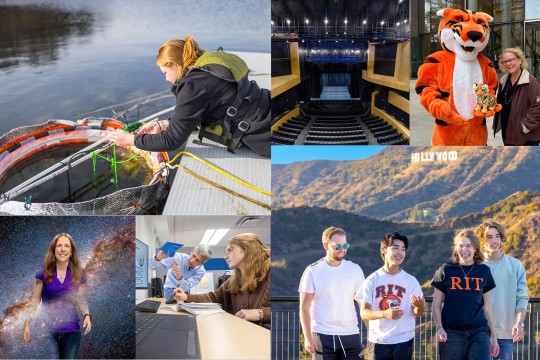RIT undergraduate student team qualifies for First Nations High Power Rocket Launch
Abby Reigner leads multidisciplinary team to represent RIT for the first time at a national aerospace challenge focused on Native American communities
Traci Westcott/RIT
RIT undergraduate students participating for the first time in the annual First Nations High Power Rocket Launch are, from left, Abigail Reigner, Ka’ualani Ceberano, Nathaniel Kilbridge, and Justin Tebbutt. They were joined by teammates Michael Elrod and Caitlyn Peck for a project meeting in Engineering Hall to build rocket components for their competition rocket.
For the first time, Rochester Institute of Technology will be represented at the First Nations High Power Rocket Launch design competition taking place this April in Wisconsin. As one of only 24 U.S. collegiate teams qualifying for the event, six RIT undergraduate students are committed to building both a high-powered rocket for the challenge and a sense of community and pride.
Competitions such as the First Nations launch encourage Native American scholars to apply classroom learning to real-world scenarios. The competition requires teams to build a rocket equipped with a payload drone to reach an altitude of 2,500 feet and descend toward a specific landing zone.
Abigail Reigner (Comanche), the Rocket Launch project leader, said the team is very enthusiastic about the project, even when faced with a significant challenge like only one of the members having experience building a rocket.
“It’s technically challenging, but with the combined efforts of this group, we jumped in head first,” said Reigner, a fifth-year mechanical engineering BS/MS student in RIT’s Kate Gleason College of Engineering. “We look at this project as one where we can do this in parts. This is about assembling a system, made up of different parts that have to be integrated together.”
Focusing on integration is as much about rocket components as it is about the eclectic team of students from different RIT programs. Mike Elrod, a fifth-year mechanical engineering from Colchester, Conn., was a design lead on RIT’s Launch Initiative and brings competition and build experience to the group.
“He explained what needs to be done—and then some. His innovative ideas helped us shape the design of the rocket and drone,” said Reigner.
Others making up the team are:
- Caitlyn Peck (fifth-year, electrical engineering, Cobleskill, N.Y.), leads design of avionic systems for the rocket and drone, tracks group tasks, and oversees pertinent safety information;
- Justin Tebbutt (fifth-year, electrical engineering, Ridgefield, Conn.), is working to obtain his FAA drone pilot license. He is working on specifications for the drone’s electronic system to ensure transmission data between the drone and ground crew.
- Kaualani Ceberano (Native Hawaiian, second-year, motion picture science, Kapolei, Hawaii) is assistant project manager, and Nathaniel Kilbridge (Q’eqchi Maya, third-year, psychology, Truro, Mass.) leads project PR and communications. Both are developing an outreach program based on the project they’ll present to students at the Harley School in Rochester to talk about college experiences and potential careers.
“Kaualani and Nathaniel are combining their experiences at RIT so far with their knowledge of indigenous communities to plan and implement a K-12 activity that is not only STEM-based but also incorporates the Future Steward Program attitude toward everyday indigeneity. They are working with FSP adviser Kendall Scott,” said Reigner.
The Annual First Nations Launch is open to students attending a Tribal College or university, a Native American-serving non-tribal institution or who are active in the American Indian Science and Engineering Society (AISES). Reigner was instrumental in writing the project proposal that won two funding grants—$4,000 from Launch event sponsor, Wisconsin Space Grant Consortium, and a $2,000 NASA New York State Space Grant. She heard of the competition through her connections to several campus and professional groups including RIT’s Future Stewards Program and AISES, two of the many organizations on and off campus she remains involved with as a student leader.
Opportunities for Native American/First Nations students is important to Reigner personally and as someone seeking a career in engineering. Reigner, from Boyertown, Pa., expects to graduate this May. When she began at RIT, she selected the university as one that had a strong Native American affinity program.
“This is a way to share cultures, to learn about New York’s Native people, the Haudenosaunee, and to connect to this great culture,” she said. “Programs like the rocket competition become so much more that putting together different technologies. It’s a way to be role models for other Native American students who are considering college. This is a way for them to see that RIT can deliver on its commitment to students from our communities and maybe attract more students.”






